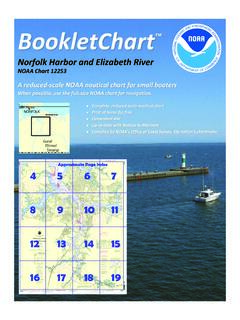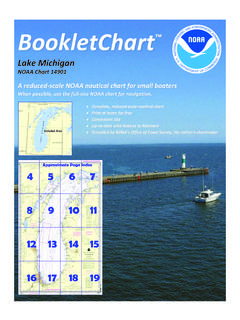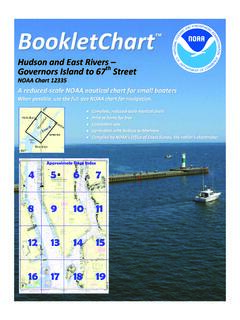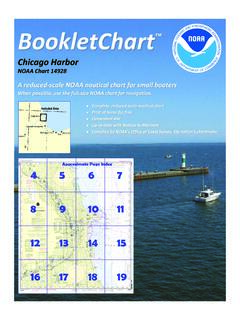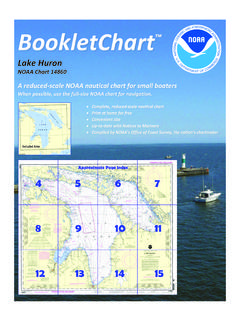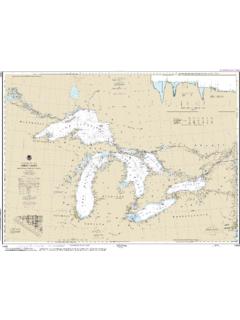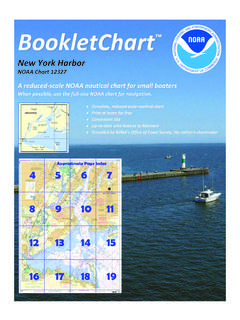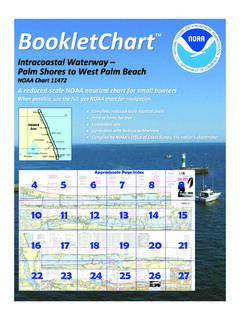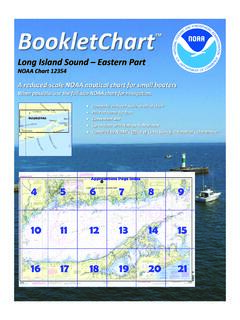Transcription of Tampa Bay - National Oceanic and Atmospheric Administration
1 BookletChart Tampa Bay NOAA Chart 11416 A reduced-scale NOAA nautical chart for small boaters When possible, use the full-size NOAA chart for navigation . 2 Published by the National Oceanic and Atmospheric Administration National Ocean Service Office of Coast Survey 888-990-NOAA What are Nautical Charts? Nautical charts are a fundamental tool of marine navigation . They show water depths, obstructions, buoys, other aids to navigation , and much more. The information is shown in a way that promotes safe and efficient navigation . Chart carriage is mandatory on the commercial ships that carry America s commerce. They are also used on every Navy and coast guard ship, fishing and passenger vessels, and are widely carried by recreational boaters. What is a BookletChart ? This BookletChart is made to help recreational boaters locate themselves on the water.
2 It has been reduced in scale for convenience, but otherwise contains all the information of the full-scale nautical chart. The bar scales have also been reduced, and are accurate when used to measure distances in this BookletChart. See the Note at the bottom of page 5 for the reduction in scale applied to this chart. Whenever possible, use the official, full scale NOAA nautical chart for navigation . Nautical chart sales agents are listed on the Internet at This BookletChart does NOT fulfill chart carriage requirements for regulated commercial vessels under Titles 33 and 44 of the Code of Federal Regulations. Notice to Mariners Correction Status This BookletChart has been updated for chart corrections published in the coast guard Local Notice to Mariners, the National Geospatial Intelligence Agency Weekly Notice to Mariners, and, where applicable, the Canadian coast guard Notice to Mariners.
3 Additional chart corrections have been made by NOAA in advance of their publication in a Notice to Mariners. The last Notices to Mariners applied to this chart are listed in the Note at the bottom of page 7. Coast Pilot excerpts are not being corrected. For latest Coast Pilot excerpt visit the Office of Coast Survey website at [Coast Pilot 5, Chapter 9 excerpts]. Port Manatee is a deepwater terminal on the SE side of Tampa Bay. The terminal is reached through a channel that leads SE from the main ship channel. A Federal project provides for a depth of 40 feet in the channel and turning basin. The channel is marked by a lighted range, lights, and lighted buoys. Hillsborough Bay, a Federal project, provides for depths of 43 feet in the channels leading through Hillsborough Bay. Good anchorage is available for shallow-draft vessels in the central part of the bay W of the main channel.
4 Federal project provides for depths of 34 feet for the main ship channel, Sparkman and Ybor Channels, and Ybor Turning Basin, and 12 feet for Seddon and Garrison Channels. Only small boats can pass around the N end of Davis Islands. Two fixed bridges connect the N end of the islands with Tampa to the W; minimum clearance is 9 feet. A no-wake speed zone is enforced in the area between the southern tip of Harbour Island and Platt Street bridge. Small-craft facilities in Tampa are limited. The municipal boat landing is on the W side of the entrance to Hillsborough River. The Majorie Park Yacht Basin on Davis Islands, on the W side of Seddon Channel, has gasoline, water, a launching ramp, and open and covered berths for boats up to 50 feet. Diesel fuel is available by truck. The basin has depths of 7 feet. The entrance and all other navigable waters of Tampa Bay, Hillsborough Bay, Old Tampa Bay, and tributaries herein are within a regulated navigation area.
5 Required Reports to the CVTS. Vessels should contact the CVTS prior to entering Tampa Bay, shifting or departing dock (see paragraphs 39-51 for details). Anchorages. Vessels with good ground tackle should anchor in the Tampa Anchorages, N of the Tampa Safety Fairway leading to Egmont Channel. An emergency anchorage is S of Mullet Key in depths of 30 to 35 feet; and SW of Gadsden Point in natural depths of 29 to 32 feet. Explosives and quarantine anchorages are E of Mullet Key, NE of Papys Point, and S of Interbay Peninsula. (See and , chapter 2, for limits and regulations.) Local weather during the thunderstorm season is unpredictable, and intense winds can develop suddenly. Before entering or departing the port, mariners should obtain local weather forecasts, maintain a close watch on the weather, and ensure that light vessels are properly ballasted during the transit.
6 Safety zones have been established around vessels carrying anhydrous ammonia or liquefied petroleum gas when transiting or moored in Tampa Bay. A regulated navigation area has been established to protect vessels from limited water depth in Sparkman Channel caused by an underwater pipeline. Currents. A strong offshore wind sometimes lowers the water surface at Tampa and in the dredged channels as much as 4 feet, and retards the time of high water by as much as 3 hours. A continued SW wind raises the water by nearly the same amount and advances the time of high water by as much as 1 hour. There is a large daily inequality in the ebb, and velocities of 2 knots or more may be expected at the strength of the greater ebb of the day in Egmont Channel, Passage Key Inlet, and off Port Tampa . Flood velocities seldom exceed 2 knots. Winds have considerable effect in modifying the tidal current.
7 A danger zone of a small-arms firing range of MacDill Air Force Base is on the SW shore of Interbay Peninsula. (See , chapter 2, for limits and regulations.) coast guard Rescue Coordination Center 24 hour Regional Contact for Emergencies RCC New Orleans Commander 8th CG District (504) 589-6225 New Orleans, LA G Lateral System As Seen Entering From Seaward on navigable waters except Western Rivers PORT SIDE ODD NUMBERED aids GREEN LIGHT ONLY FLASHING (2) PREFERRED CHANNEL NO NUMBERS MAY BE LETTERED PREFERRED CHANNEL TO STARBOARD TOPMOST BAND GREEN PREFERRED CHANNEL NO NUMBERS MAY BE LETTERED PREFERRED CHANNEL TO PORT TOPMOST BAND RED STARBOARD SIDE EVEN NUMBERED aids RED LIGHT ONLY FLASHING (2) FLASHING FLASHING OCCULTING GREEN LIGHT ONLY RED LIGHT ONLY OCCULTING QUICK FLASHING QUICK FLASHING ISO COMPOSITE GROUP FLASHING (2+1) COMPOSITE GROUP FLASHING (2+1)
8 ISO "1" Fl G 6s G "9" Fl G 4s GR "A" Fl (2+1) G 6s RG "B" Fl (2+1) R 6s "2" Fl R 6s 8 R "8" Fl R 4s LIGHT G C "1" LIGHTED BUOY G "5" GR "U" GR C "S" RG N "C" RG "G" LIGHT 6 R N "6" LIGHTED BUOY R "2" CAN DAYBEACON CAN NUN NUN DAYBEACON For more information on aids to navigation , including those on Western Rivers, please consult the latest uscg Light List for your area. These volumes are available online at 2 2 C U 5 1 VHF Marine Radio channels for use on the waterways:Channel 6 Inter-ship safety 9 Communications between boats and 13 navigation purposes at bridges, locks, and 16 Emergency, distress and safety calls to coast guard and others, and to initiate calls to other vessels. Contact the other vessel, agree to another channel, and then 22A Calls between the coast guard and the public.
9 Severe weather warnings, hazards to navigation and safety warnings are broadcast 68, 69, 71, 72 and 78A Recreational boat and Giving Help Signal other boaters using visual distress signals (flares, orange flag, lights, arm signals); whistles; horns; and on your VHF radio. You are required by law to help boaters in trouble. Respond to distress signals, but do not endanger INFORMATIOND istress Call Procedures Make sure radio is on. Select Channel 16. Press/Hold the transmit button. Clearly say: MAYDAY, MAYDAY, MAYDAY. Also give: Vessel Name and/or Description;Position and/or Location; Nature of Emergency; Number of People on Board. Release transmit button. Wait for 10 seconds If no responseRepeat MAYDAY ALL PERSONS PUT ON LIFE JACKETS!This Booklet chart has been designed for duplex printing (printed on front and back of one sheet).
10 If a duplex option is not available on your printer, you may print each sheet and arrange them back-to-back to allow for the proper layout when ReferencesNautical chart related products and information- chart catalog - a chart discrepancy- and chart related inquiries and comments- updates (LNM and NM corrections)- Pilot online- and Currents- Forecasts- Data Buoy Center- web portal for coastal conditions- Weather Service- Hurrican Center- Tsunami Warning Center- Us- s Office of Coast Survey The Nation s ChartmakerFor the latest news from Coast Survey, follow @NOAA chartsNOAA Weather Radio All Hazards (NWR) is a nationwide network of radio stations broadcasting continuous weather information directly from the nearest National Weather Service office. NWR broadcasts official Weather Service warnings, watches, forecasts and other hazard information 24 hours a day, 7 days a week.
